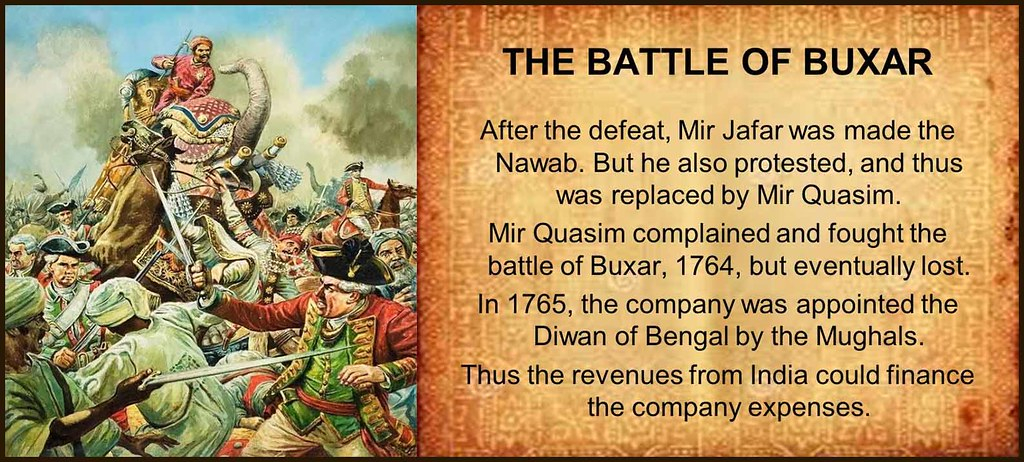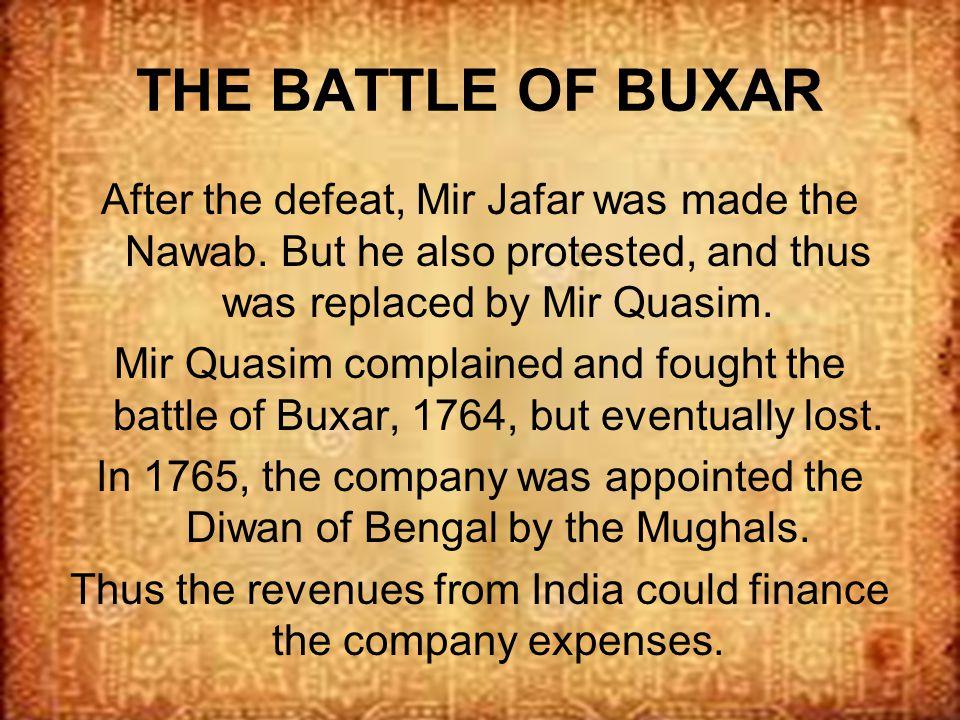Battle of Buxar Origins and Effects – Decisive battle for expansion of English trade


In 1764, the Battle of Buxar was pivotal combat between the English army and the Bengal Nawab, Mir Kasim, Shah Alam II, & the Mughal Emperor’s united army. The conflict resulted from the misapplication of trade permits by Dastak and Farman as well as English trade amplifying goals. The Company determined that Mir Kasim might be a perfect servant goals. at another extreme, Mir Kasim confounded the Standards of the company.
Bihar’s deputy minister, Ram Narayan, has repeatedly failed to comply with the nawab’s demands to submit the state’s income accounts.
Powerless Mir Kasim in the face of certain flagrant disobedience of his authority. The English administrators in Patna, on the other hand, backed Ram Narayan.
Mishandling of the Industry’s dastak or trading authorization (permission which spared certain items from tariff settlement) by Company officials added to the nawab-English conflicts. As a consequence of dastak’s misappropriation, the nawab squandered tax money.
it forced Local tradesmen to tussle unjustly with Company merchants. Through an imperial Farman, the English business had obtained the right for trading throughout Bengal with no charges and transit dues or tolls. The Company’s servants, on the other hand, demanded similar liberties for their enterprise. The Company’s slaves also marketed Dastak for merchants of India commission. Moreover, they employed compulsion to get lower-cost goods and it’s against the duty-free trade principles. Duty-free purchasing started finding a good offers in an already tough sector.
Check out our latest article about Alexander The Great – King Of Macedonia | Criss Cross Tamizh
The British complained and demanded favorable treatment from other merchants, so Mir Kasim opted to completely erase the taxes. In 1763, a conflict between the Nawab and the Company regarding transit duties prompted a battle among them.
In fast sequence, the English triumphed at Katwah, Gina, Munger, Sooty, as well as Murshidabad, Mir Kasim withdrew to Oudh when he established the coalition together Shuja-ud-Daulah, the Awadh Nawab, and Shah Alam II, the Mughal Emperor, for seizing Bengal again from English.
Invasion of Buxar Incident
A British force of 10,000 soldiers mercilessly beats a united troop comprising 40,000 menas from the Mughal emperor, Awadh, as well as Mir Qasim. One of the fundamental causes of this failure occurred due to a lack of cooperation amidst the leading 3 distinct allied forces.


Captain Hector was capable to coordinate the British defenses under twenty minutes and stop the Mughals Army’s approach led by Mirza Najaf Khan, the Mughal Army’s front wing to attack the British at daybreak.
Munro split the troops of the British as columns and through shooting up the bridge of the boat after Shuja-ud-Daula, crossing the river followed him. Shah Alam II was forced to leave their fight as a result of such an unanticipated consequence.
Check out our latest article about The Successors Of Shivaji: Detailed Overview – CCT
The British faced the struggle of 847 losses, on the other hand, India suffered a loss of 2000 troops. Later Munro determined to favor Marathas. Therefore no unity among Marathas and Nawabs as they fight with each other and possessed a steadfast enmity toward them. Hector Munro served in the British military as a major. During the Buxar war, He commanded the English forces. Robert Clive authorized several treaties amidst Shuja-Ud-Daulah and Shah Alam-II as a result of victory in battle.
Outcomes of the Fight against Buxar
On 1764 October 22, The combined armies of Mir Kasim and Shah Alam II got defeated by English soldiers guided by Major Hector Munro. The counter provided by English opposing Mir Kasim proved quick but successful.
The battle was remarkable because both The Mughal ruler and Bengal Nawab were vanquished by the English. In 1763 Mir Jafar, who was also referred to as Nawab 1763 when negotiations between the Company and Mir Kasim deteriorated, agreed to hand up the regions of Midnapore, Chittagongas well Burdwan to the English for military reinforcement after the fight.
Excluding a two percent salt tariff, the English were granted duty-free commerce in Bengal. Mir Jafar’s underage son, Najimud-dula, was named nawab after his death, but the naib-subahdar, who could be chosen or fired by the English, had the true administrative power.
The Treaty of Allahabad
The Treaty of Allahabad was signed in 1765, and it was the first treaty signed in India. Robert Clive signed two major contracts with the Nawab of Awadh and Shah Alam II at Allahabad in August 1765.
Nawab Shuja-ud-Daula decided to hand up Allahabad as well as Kara for Shah Alam II, as well as pay the Company Rs 50 lakh in war reparations.
Transfer his whole land to Balwant Singh, the Banaras Zamindar.
Check out our latest article about The Great Story Of Shivaji’s Maratha Administration In CCT
Shah Alam II accepted to dwell through Allahabad, which Nawab of Awadh granted to him, under the safety of the East India Compay. Issue a Farman granting the Diwani of Bengal, Bihar, as well as Orissa to the East India Company, Deal in return for an annuity due of Rs 26 lakh; and a grant of Rs 53 lakh to the Company in consideration for the nizam functions of the abovementioned provinces (army defense, police, as well as administration of justice.
Conclusion
Clive avoided annexing Awadh as it would require the Company to defend a huge land frontier against Afghan and Maratha assaults. The treaty converted the Nawab into a loyal Company friend, and Awadh became a client state. Clive’s deal with Shah Alam II was also driven by practical considerations.


The Emperor became a useful ‘rubber stamp’ for the Company as a result of this.
The emperor’s Farman also legitimized the Company’s political victories in Bengal. Mir Kasim, Bengal’s unseated Nawab, died in June 1777 after spending the final days in grinding poverty.
The Battle of Buxar occurred on 22nd October 1764, and the Indian army was defeated. The Battle of Buxar came to be a watershed moment in Indian history.
Shuja-ud-daulah and Shah Alam signed treaties with Clive, who had become the company’s Governor, at Allahabad in 1765.
The English firm obtained the Diwani of Bengal, Bihar, and Odisha as a result of these treaties, which granted the corporation the power to collect money from these regions. The Mughal Emperor started to stay at Allahabad under the security of British troops when the Nawab of Awadh submitted Allahabad and Kora to him. The corporation committed to pay the Mughal ruler a Sum of Rs 26 lakhs every year, but they quit paying him soon after.
Check out our latest article about Development Of Education During The British Period In India – British Education
The business offered to provide troops to protect the Nawab opposing any intruders in exchange for payment from the Nawab. As a result, the Nawab of Awadh grew reliant on the firm. Meanwhile, Mir Jafar had been re-installed as Nawab of Bengal. His son became appointed as the Nawab after his death. By accepting bribes from the Nawab, corporate leaders generated tremendous personal benefits.
